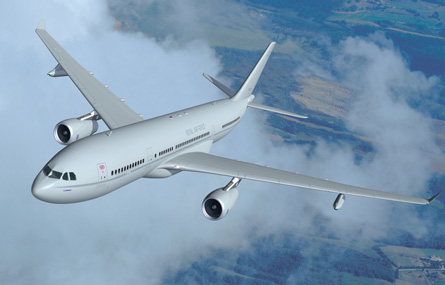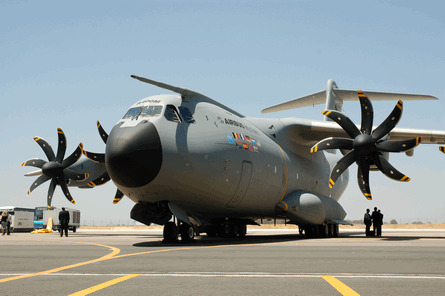After maintaining an optimistic front throughout last year, EADS has finally conceded that the problems facing Europe's Airbus Military A400M programme are of a scale equal to the giant transport, and called on its partner nations to negotiate a new contract to complete development and production of the type.
Lead stakeholder EADS on 9 January announced that it was seeking "a new approach" for the troubled A400M project, after its plans to fly the first production aircraft from mid-2008 failed to become reality. EADS chief executive Louis Gallois says this is intended to reflect "the military nature of the programme" and the risk involved, but any change to the current €20 billion ($26.6 billion) A400M deal will be the subject of intensive and difficult negotiations between industry, the programme's seven launch nations and Europe's OCCAR procurement agency over the coming months.
The new EADS proposal hinges on resuming production activities only after flight-testing of the A400M has reached "adequate maturity", with an expectation that deliveries will begin "around three years after first flight". It also calls for changes to undisclosed "technical characteristics" of the airlifter.
 |
|---|
© Airtanker |
Speaking in Newport in the UK on 13 January, Gallois attributed the A400M's severe delays to a "complete underestimation of the nature of the programme" by EADS, its suppliers and customers. The aircraft had been viewed as a "flying truck", or "normal Airbus", he said, but has proved more complex than the programme's original schedule allowed. This said that in-service equipment would be delivered within just 77 months of a contract signature, made in May 2003.
MISSION IMPOSSIBLE?
Speaking in Toulouse on 15 January, Airbus chief executive Tom Enders said: "With the current contractual and organisational set-up we will not get there - this is a mission impossible. We want to continue the programme, but in a way that ensures success. It would be irresponsible to continue on the current track."
Enders also claimed that "our American colleagues would run away crying if they were obliged to step up into the A400M contract". But EADS's apparently late realisation of the significant risks involved in signing single-phase development and production contracts for complex military equipment is surprising, given the dire difficulties that had been encountered by its then-Airbus partner BAE Systems on the UK's Nimrod MRA4 maritime patrol aircraft project way before the transport deal was signed.
Unlike with the Airbus A380, where development work had been under way for around four years before product launch, or the A350, which deployed derivative engines and a derivative cockpit, detailed engineering work on the A400M did not start until the contract was live. Gallois says this required EADS to "start from scratch" with every item, adding that the project's complexity exceeds that of the Dassault Rafale or Eurofighter combat aircraft, and requires both military and EASA civil certification. EADS has "a big share of the responsibility for the underestimation", he says, but "it is not alone".
ANGRY RESPONSE
UK defence secretary John Hutton says the UK "cannot accept a three- or four-year delay" in the delivery of its 25 A400Ms, and attributes the delay to "problems that EADS is having in producing the aircraft, not because of any policy decision made by the UK government or any other partner nations involved. We, along with all our partner nations, will have to consider very carefully what the right response to the problem is."
In a bid to repair the damage with his customers, Gallois last week revealed a surprise "bridging solution", under which EADS has proposed supplying modified A330s and "other airplanes" to A400M customers that require interim lift. Admitting that the A330 could only fill "a limited part of the gap", he says: "It can't be the only solution: but it could be part."
 |
|---|
© Airbus Military |
The initiative would enable the UK and other customers to use A330s to transport troops and freight, freeing assets such as Boeing C-17s and Lockheed Martin C-130s for frontline duties. Preparing the civil type for such a role would require reinforcing the cockpit and avionics systems, incorporating an inert gas generating system and installing directional infrared countermeasures equipment.
A330s are already due for delivery to the UK Royal Air Force through its Future Strategic Tanker Aircraft (FSTA) programme, and the Ministry of Defence had already been investigating the possibility of accelerating the type's availability from a current first delivery in 2011. But while the FSTA fleet could resolve a persistent problem in sustaining an "airbridge" between the UK and Afghanistan and Iraq, now provided primarily using the RAF's aged Lockheed TriStars, it would not address the UK's looming tactical transport crisis.
Fatigue on the RAF's C-130Ks and newer C-130Js makes the A400M's availability vital, with deliveries originally scheduled between 2010 and 2015. Hutton's comments fell short of threatening to withdraw from the A400M project: a move which would have serious financial and political implications, and potentially also damage the interests of British industry, which has hundreds of employees working on the aircraft, including in the final assembly of its composite wing. But the MoD says a range of options are being considered, including "reallocating assets, extending the out-of-service date of the C-130K and leasing or procuring additional assets - for example C-17s or C-130s".
The RAF has a long-held aspiration to expand its current fleet of six C-17s, and the MoD cautions: "The A400M is a fixed-price contract, and we are under no obligation to change this or accept an increase in price."
Other partner nations could also seek to buy or lease C-130Js or C-17s as a result of the delay. Jim Grant, Lockheed's vice-president, business development, Air Mobility, says: "Lockheed Martin understands the importance of ensuring nations have both strategic and tactical air mobility capability, and we are committed to continuing to do our part to help nations fulfil their critical airlift missions."
While declining to comment on specific opportunities, the C-17's manufacturer says: "The Boeing Company, with the support of the US Air Force, is ready as always to support our international customers with additional orders."
Germany is already investigating a further life-extension to some of its C160 Transalls to plug the gap until the A400M is operational, but it is unclear what options are being considered by the programme's launch operator, France, which should have fielded its first example late this year.
UNCERTAIN FUTURE
While asserting the need for "a clear, visible time schedule", Gallois is unable to commit to a date for the A400M's first flight, saying only that it will happen one month after delivery of the full-authority digital engine control software for its Europrop International TP400-D6 turboprop engines. The FADEC issue is on "the critical path", he adds.
Industry sources say the one TP400 flown for the first time on a C-130 testbed in the UK on 17 December has been given a clean bill of health following post-flight inspections, and that the aircraft should return to the sky before the end of January. Initially flown at around 30-35% of its 10,000shp (7,460kW) output, the powerplant could be taken to maximum power after between seven and 10 test flights, one source adds. Enders believes the testbed could conclude its work "in the next couple of months", enabling the first A400M to fly later this year.
EADS says it could have flown the A400M last October, had the final FADEC software been available, and blames the engine choice for many of the A400M's problems. The EPI consortium started work on the TP400 at the behest of the programme's partner nations, while the airframer had opted to acquire an off-the-shelf solution from Pratt & Whitney Canada. This compromise was one of the project's most risky, and damaging decisions.
For its part, EADS has already acted to rationalise its management structure for the A400M, which Enders says was previously "overly complex, or put more bluntly, a little bit politically polluted". It will now merge its Military Transport Aircraft division within Airbus as Airbus Military, bringing the A400M and other military derivative projects under more streamlined control, and has sought "tighter links" with its suppliers.
EADS meanwhile declines to comment on media reports which have claimed that the A400M is overweight by as much as 12t, and is falling short of its required cargo capacity by around 3t, with one source commenting only that the effort is encountering issues "common with any military development".
But its proposal to delay further production until after flight tests have reached a suitable level is driven by a wish to avoid costly retrofit activity after several aircraft have been completed. Aircraft MSN002 is still in final assembly in Seville, while the delivery of structures for the programme's third aircraft were halted several months ago, with EADS saying some modifications have already been identified.
Gallois declines to specify EADS's proposed changes to the A400M's technical characteristics, but rules out any downgrading of the aircraft. "We feel that we have some margin for discussing some specifications that are extremely demanding, costly, risky and not bringing the necessary value for customers," he says.
At EADS's lavish roll-out event for the first A400M last June, Airbus Military chief executive Carlos Suarez described the project as a "formidable challenge", but only now has the balloon gone up on quite how severe the task facing the project really is. Repairing the damage will be a strong test for OCCAR's management skills, as it must now prove its worth by brokering a swift resolution to the crisis to Europe's biggest collaborative defence programme.
By Gallois' estimate, EADS has allocated 6,000 employees to the A400M, and has so far made financial provisions of €1.75 billion to reflect programme delays. Gallois insists that the eventual outcome will be a "fantastic airplane", with logistical and tactical performance "second to none", and the potential to add new export orders to those from Malaysia and South Africa once the programme is considered secure. "I'm not pessimistic at all," he says.
More images for the Airbus Military A400M from AirSpace
Additional reporting by Max Kingsley-Jones in Toulouse and Craig Hoyle in London
Source: Flight International























